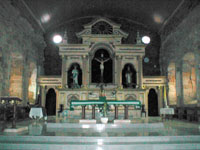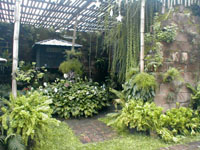The echoes of Alimodian Church
Text and Photos
Wein P. Gadian
The Spanish colonization in the Philippines left marks in our infrastructures, buildings and churches. The churches were built during the unforgettable Spanish colonization in the pueblos, and Alimodian was one of those places. The century-old church seated at the heart of the town was then known for its beauty and splendor. Its belfry was one of the tallest and the most beautiful in Panay and Negros. Since its first construction in 1787, the church had been shaken by four earthquakes (1787, 1869, 1887 and 1948). These caused the destruction on some parts of the church, but it was the 1948 earthquake called Lady Kaykay that contributed to the final collapse of the convent and the belfry. Two thirds of the belfry was destroyed and brought the bells to rest on solid ground (except for the biggest mayor). Years after its fall, the bell remained deeply buried on the ground, which the Alimodiananons could not move because of its heavy weight of 1,470 kilos.
 |
Its construction was a product of Alimodiananon’s sweat and blood. Forced labor was implemented in the construction and the gathering of materials. Each was given a quota and in every failure an inhuman punishment called flogging was carried out. Labor was not paid and the workers provided their own food. Even the women and children participated in the building of the said church. They were the ones who gathered the white stones and turned them into lime. It took hundreds of men to pull up the bells to the belfry. All the bells were made with alloy of silver.
Every toll of the bell was a signal for the residents lined up along the streets to offer alms of Spanish coins as their contribution.
During the Japanese Era it had served as refuge of the rich from Iloilo City and Ilonggos from other areas of the province. One of the most interesting stories about the church was that of documents placed inside the jar, or Barcelona, mixed with coins of one sicualohon (P0.6 1/4), one sicapaton (P12 ¼), one capatihon (P 0.25), one salapion (P.50), one pisoson (P!) and a gold necklace. This Barcelona was covered and placed inside a log (tabla) which was prepared like trough big enough to hold the jar. Then it was sealed with lime and buried under the main door of the church. The said documents were signed by the town and the church high officials seventy four years after its first construction. (Alimodian: Its Yesterday, Today and Tomorrow).
 |
At present, the church reconstruction include the floorings covering the biggest mayor, the convent, roofing, and its beams among others. The mini garden between the convent and the church was utilized for receptions for weddings, parties and other celebrations. The garden has an aviary which attracts tourist. There are tropical plants surrounding it, another attraction is the grotto of our Lady which speaks of Alimodiananon’s devotion to Mary. The beautiful church still rest at the heart of the town. And despite the earthquakes, wars it has been through—its ruins tells a story every Alimodiananons will never forget.
|
|

